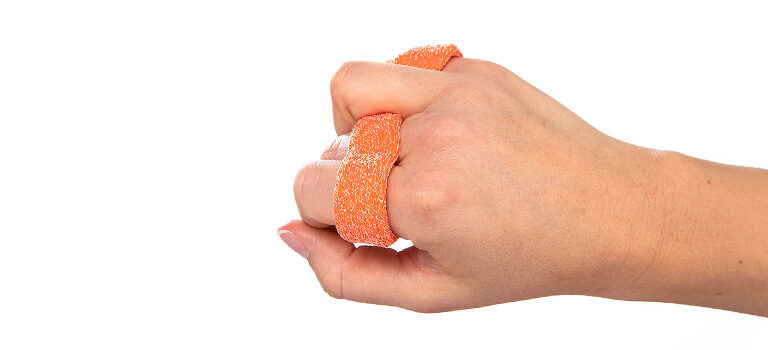
Splint in the Spotlight: Dorsal Blocking Orthosis

Our Orfit blog shares information and instructions in matching our thermoplastic materials to orthotic designs.
Please check back frequently to gain inspiration and ideas in orthotic fabrication for all of your patient’s needs.
Today we are focusing on the Dorsal Blocking Orthosis for management of post-operative flexor tendon and peripheral nerve rehabilitation. The Dorsal Blocking Orthosis is a dorsally placed immobilization orthosis designed to protect the sutured/repaired flexor tendons and/or nerves in a tension free position. Other names for this splint include Extension Block Splint, Dorsal shell, and Dorsal Protective splint.
Pathology:
Tendon lacerations are common injuries seen in the hand therapy clinic. Rehabilitation of these injuries can be challenging; complications include tendon ruptures and tendon adhesions. There are various post-operative rehabilitation protocols which are often selected based on the surgeon’s suturing technique or preference. Recent advancements in suture technique and style have allowed early active motion protocols and changes in orthotic design. The exact positioning of the wrist and metacarpo-phalangeal (MCP) joints in flexion may vary from protocol to protocol allowing wrist positioning in 0-45° of flexion and MCP joints in 60-90° flexion. Many therapists today follow a combination of different protocols, incorporating passive flexion of the finger joints, active extension of the fingers into the dorsal shell and allowing the fingers to rest in protected extension at night.
Regardless of the exact posturing, the dorsal blocking orthosis is a forearm based splint that prevents wrist extension, maintains the MCP joints in flexion, and the inter-phalangeal (IP) joints in extension.
This orthosis can be easily modified to the following:
- The synergistic orthosis with hinged wrist as outlined in the Indiana Flexor Tendon protocol;
- A hand based orthosis if only a digital nerve is repaired;
- If the wrist flexors are involved, but not the finger flexors, then the orthosis can be shortened to end at the PIP joint level dorsally.
The goals of the splinting protocol are to protect the repair site, but allow limited active motion in order to prevent adhesions and minimize edema.
Patients need to be instructed to wear the splint full time. Functional activities with the involved hand should be avoided and instructions to cover the splinted extremity during bathing should be issued.
Patients should be cautioned not take off their splint as they could easily rupture the repair with any active flexion of the repaired tendon.
Splint solutions:
Orfilight and Orfilight Black NS in 3.2mm (1/8”) work very well for this orthosis. Simply cut a rectangle of material (15 cm x 30 cm/ 6” x 12”).
Fabrication Technique:
To fabricate the dorsal blocking splint, rest the patient’s involved elbow on the table with their forearm pronated, and the wrist and MCP joints flexed according to the protocol specifications. The IP joints should be in maximum extension. Have the patient place their opposite fist underneath the injured hand for support during the orthotic fabrication process.
Activate the material in hot water. Dry slightly and lay one edge of the material over the fingertips, catching it slightly so it stays in place. Stretch the material proximally over the forearm. Make sure not to hold the material in any one spot to reduce the chance of finger printing and pressure spots. You can hold the corners of the material near the proximal forearm as these can easily be trimmed away. Let the stretched material conform with gravity to the bony prominences of the ulnar styloid and the flexed MCP joints. Give minimal support and pressure at the wrist level and at the MCP joint level. Let the material harden sufficiently before removing to trim.
When hardened, remove the splint and trim all sharp edges and corners away. There should be no material on the volar surface of the palm and forearm. The patient should be able to passively flex each finger joint into the palm and actively extend each finger inside the splint shell.
Dorsal blocking orthoses can be fabricated for the treatment of:
- FDS and/or FDP repairs
- FPL repairs
- Digital nerve repairs
- Post-operative Dupuytren’s release to limit full extension of the fingers
Questions?
If you have a question or comment, please post it in the Orfit Splinting & Rehabilitation Group on Facebook, or send an email to welcome@orfit.com.



